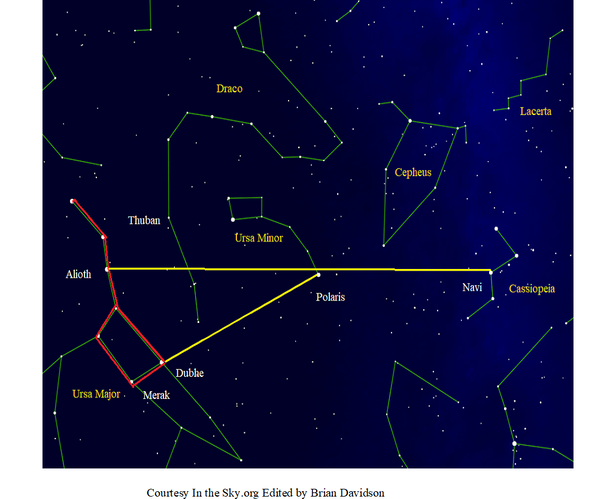|
The July evening sky didn’t disappoint with lots of comments about the full Moon and the nice clear skies. The striking images released from the James Webb Space Telescope were an added bonus. Observing The following chart represent the night sky at 11.00pm BST on the 8th of August and at 10.00pm BST on the 23rd August. To use the chart, face your northern horizon (we normally face south) at the appropriate time and you will see the stars in the chart. Our focus this month is a few of the circumpolar constellations. These are the ones which rotate anti-clockwise about the north pole star (Polaris) and never drop below the horizon and are visible all year round during the hours of darkness. So facing north you will immediately see towards your lefthand side, The Plough, the well known asterism in the constellation Ursa Major- The Great Bear. It is one of the larger constellations but it is difficult to make out the shape of a bear whereas The Plough, outlined in red on the chart, is instantly recognisable. Names are shown for three of its stars and we shall use these to navigate our way around the sky. First extend the line from Merak to Dubhe (known as the pointers) about x5 the distance between the two stars (shown by a yellow line in the chart) and you arrive at Polaris- The North Pole star. It is a yellow supergiant, not particularly bright at magnitude 2 but easy to locate as it is on its own. It lies about half a degree from the north celestial pole and has been used by mariners for centuries to find their way about the oceans particularly in the days of sailing ships. It is the brightest star in the constellation Ursa Minor- The Little Bear. This small constellation mimics the shape of The Plough and so Polaris sits at the end of its handle.
Now take a line from Alioth in The Plough and extend it through Polaris about the same distance again (shown by the second yellow line in the chart) and you see a bright star, the central one of a ‘W’ formation. This ‘W’ shape is an asterism in the constellation Cassiopeia- Queen Cassiopeia in Greek mythology and wife of King Cepheus. Most people see the ‘W’ shape and call it Cassiopeia. The bright star was never given a name but it was apparently used for navigation in early space missions and has been given the name Navi, an anagram of the middle name of Virgil (Gus) Ivan Grissom who lost his life in the pursuit of space exploration. This is probably the best time of year to see The Plough and Cassiopeia because neither one is close to the horizon. These two always keep their same shape but change their orientation as they rotate about Polaris throughout the year. Maybe it’s just me but I find it a great pleasure to watch them as they change positions in the sky. It is also a great help to have two such easily recognisable star formations to find your way about the sky. For the next few months Cassiopeia will rise higher in the sky and you will be able to enjoy it at its best while the plough sinks closer to the horizon. Still facing north you will see to the west of Cassiopeia and towards your zenith a group of not very bright stars forming a shape similar to the gable end of a house. This is the constellation Cepheus- King Cepheus in Greek mythology and husband of Queen Cassiopeia and father of Princess Andromeda. It contains the prototype of an important group of variable stars called ‘cepheid variables’ which have been fundamental in establishing a ‘standard candle’ for the measurement of intergalactic distances and the rate of expansion of the universe. Another large constellation, Draco- The Dragon, has no stars brighter than magnitude 2 but its tail is to be found wrapping itself around Ursa Minor. It has one star of particular significance, Thuban, due to the fact that 5,000 years ago it used to be the north pole star but due to the precession of the earth’s axis (like the wobble of a spinning top) the celestial pole traces out a circle over a period of about 26,000 years and over the last 5,000 years it has moved from Thuban to Polaris. Finally, and just for completeness, above Cassiopeia lies the small and obscure constellation, Lacerta- The Lizard. Even its brightest star is just brighter than magnitude 4 so unaided observation becomes a challenge. Something to look out for There will be a close approach of the Saturn and the Moon on Friday 11th August, being visible as they rise about 10.00pm BST above your south-eastern horizon and reaching their highest point about 1.30am above your southern horizon. Saturn will be at opposition on Sunday 14th August so we will soon be able to enjoy it in the evening sky for some time. (Sorry for my mistake last month, I inadvertently put in the date for 2021.) We can also look forward to Jupiter being at opposition on the 26th September. Clear skies.
0 Comments
Leave a Reply. |
AuthorWMA members Archives
July 2024
Categories |
Proudly powered by Weebly


 RSS Feed
RSS Feed